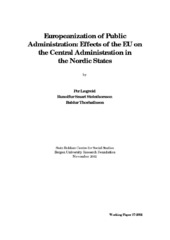| dc.contributor.author | Lægreid, Per | eng |
| dc.contributor.author | Steinthorsson, Runolfur Smari | eng |
| dc.contributor.author | Thorhallsson, Baldur | eng |
| dc.date.accessioned | 2006-06-22T09:02:15Z | |
| dc.date.accessioned | 2020-12-10T06:34:03Z | |
| dc.date.available | 2006-06-22T09:02:15Z | |
| dc.date.available | 2020-12-10T06:34:03Z | |
| dc.date.issued | 2002-11 | eng |
| dc.identifier.issn | 1503-0946 | |
| dc.identifier.uri | https://hdl.handle.net/1956/1426 | |
| dc.description.abstract | This paper examines the Europeanization of the Public Administration in the Nordic countries and explores the apparent similarities and differences of the changes in the central administration due to EU and EEA membership. The focus is on Sweden and Finland, which recently have joined the European Union, and Norway and Iceland, which relationship to the European integration is based on the EEA treaty. The paper is based on a survey conducted in all ministerial departments and directorates in the Nordic countries. It describes the degree to which the daily operations of the central administration are affected by the EU/EEA regarding networks of contact and participation towards the EU; towards political leadership; changes in forms of organization, identities and relations of influence. There are significant differences in the adaptation patterns between EU members and EEA members, but also important differences between countries with the same form of affiliation to the EU. The adaptation pattern due to the EEA membership of Norway and Iceland seem to follow a somewhat different path. To understand this we have to add structural factors like the size of the public administration. Iceland has a much smaller and less specialized civil service. Also the institutional context of the domestic administrative tradition and strategy has to be taken into account. Iceland is the only Nordic state that has not applied for a membership of the EU. It is a latecomer in adaptation to European integration, the public administration has weaker experiences with international cooperation and its autonomy from political leaders has generally been lower than in the other countries. | en_US |
| dc.description.abstract | Dette paperet undersøker i hvilken grad sentralforvaltningene Finland, Sverige, Norge og Island endres som følge av endret tilknytningsform til EU. Paperet er basert på en survey som ble gjennomført til alle avdelinger i departementer og direktorater i de nordiske landene. Det undersøkes om det daglige arbeidet i sentraladministrasjonen er påvirket av EU-medlemskapet og EØS-avtalen når det gjelder kontakt og deltakelsesmønster overfor EU, politisk ledelse og internt i det administrative apparatet. Også endringer i organisasjonsformer, identiteter og innflytelsesrelasjoner undersøkes. Det fokuseres spesielt på betydningen av formell tilknytningsformer til EU og det avdekkes tydelige forskjeller i tilpasningsmønsteret mellom EU-land og EØS-land. Men det er også viktige forskjeller mellom land med samme tilknytningsform til EU. Særlig avdekkes det forskjeller i den det norske og den islandske tilpasningen. For å forstå dette må det tas hensyn til strukturelle faktorer som forvaltningsapparatets størrelse og ulike nasjonale institusjonelle tradisjoner og strategier. Island er det eneste landet i Norden som ikke har søkt om medlemskap i EU. Tilpasningen til den europeiske integrasjonen har skjedd relativt sent. Forvaltningen har mindre erfaringer med internasjonalt samarbeid og dens autonomi fra politisk ledelse har gjennomgående vært mindre enn i de andre nordiske landene. | no |
| dc.format.extent | 82910 bytes | eng |
| dc.format.mimetype | application/pdf | eng |
| dc.language.iso | eng | eng |
| dc.publisher | Stein Rokkan Centre for Social Studies | eng |
| dc.relation.ispartofseries | Working Paper | en |
| dc.relation.ispartofseries | 17-2002 | en |
| dc.title | Europeanization of Public Administration: Effects of the EU on the Central Administration in the Nordic States | eng |
| dc.type | Working paper | eng |
| dc.subject.nsi | VDP::Samfunnsvitenskap: 200 | nob |
